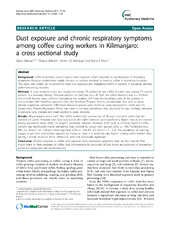| dc.contributor.author | Sakwari, Gloria | en_US |
| dc.contributor.author | Bråtveit, Magne | en_US |
| dc.contributor.author | Mamuya, Simon H. D. | en_US |
| dc.contributor.author | Moen, Bente E. | en_US |
| dc.date.accessioned | 2013-10-29T13:57:14Z | |
| dc.date.available | 2013-10-29T13:57:14Z | |
| dc.date.issued | 2011-11-24 | eng |
| dc.Published | BMC Pulmonary Medicine 11(1):54 | eng |
| dc.identifier.issn | 1471-2466 | |
| dc.identifier.uri | https://hdl.handle.net/1956/7451 | |
| dc.description.abstract | Background: Coffee processing causes organic dust exposure which may lead to development of respiratory symptoms. Previous studies have mainly focused on workers involved in roasting coffee in importing countries. This study was carried out to determine total dust exposure and respiratory health of workers in Tanzanian primary coffee-processing factories. Methods: A cross sectional study was conducted among 79 workers in two coffee factories, and among 73 control workers in a beverage factory. Personal samples of total dust (n = 45 from the coffee factories and n = 19 from the control factory) were collected throughout the working shift from the breathing zone of the workers. A questionnaire with modified questions from the American Thoracic Society questionnaire was used to assess chronic respiratory symptoms. Differences between groups were tested by using independent t-tests and Chi square tests. Poisson Regression Model was used to estimate prevalence ratio, adjusting for age, smoking, presence of previous lung diseases and years worked in dusty factories. Results: All participants were male. The coffee workers had a mean age of 40 years and were older than the controls (31 years). Personal total dust exposure in the coffee factories were significantly higher than in the control factory (geometric mean (GM) 1.23 mg/m³, geometric standard deviation (GSD) (0.8) vs. 0.21(2.4) mg/m³). Coffee workers had significantly higher prevalence than controls for cough with sputum (23% vs. 10%; Prevalence ratio (PR); 2.5, 95% CI 1.0 - 5.9) and chest tightness (27% vs. 13%; PR; 2.4, 95% CI 1.1 - 5.2). The prevalence of morning cough, cough with and without sputum for 4 days or more in a week was also higher among coffee workers than among controls. However, these differences were not statistically significant. Conclusion: Workers exposed to coffee dust reported more respiratory symptoms than did the controls. This might relate to their exposure to coffee dust. Interventions for reduction of dust levels and provision of respiratory protective equipment are recommended. | en_US |
| dc.language.iso | eng | eng |
| dc.publisher | BioMed Central | eng |
| dc.relation.ispartof | <a href="http://hdl.handle.net/1956/7453" target="blank">Dust exposure and respiratory health among Tanzanian coffee factory workers</a> | eng |
| dc.rights | Attribution CC BY | eng |
| dc.rights.uri | http://creativecommons.org/licenses/by/2.0/ | eng |
| dc.title | Dust exposure and chronic respiratory symptoms among coffee curing workers in Kilimanjaro: a cross sectional study | en_US |
| dc.type | Peer reviewed | |
| dc.type | Journal article | |
| dc.date.updated | 2013-08-23T09:34:46Z | |
| dc.description.version | publishedVersion | en_US |
| dc.rights.holder | Copyright 2011 Sakwari et al; licensee BioMed Central Ltd. | |
| dc.rights.holder | Gloria Sakwari et al.; licensee BioMed Central Ltd. | |
| dc.identifier.doi | https://doi.org/10.1186/1471-2466-11-54 | |
| dc.identifier.cristin | 903792 | |
| dc.source.journal | BMC Pulmonary Medicine | |
| dc.source.40 | 11 | |

